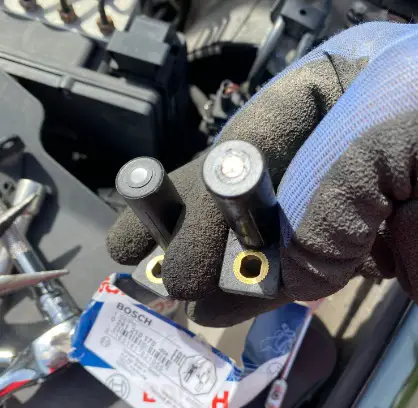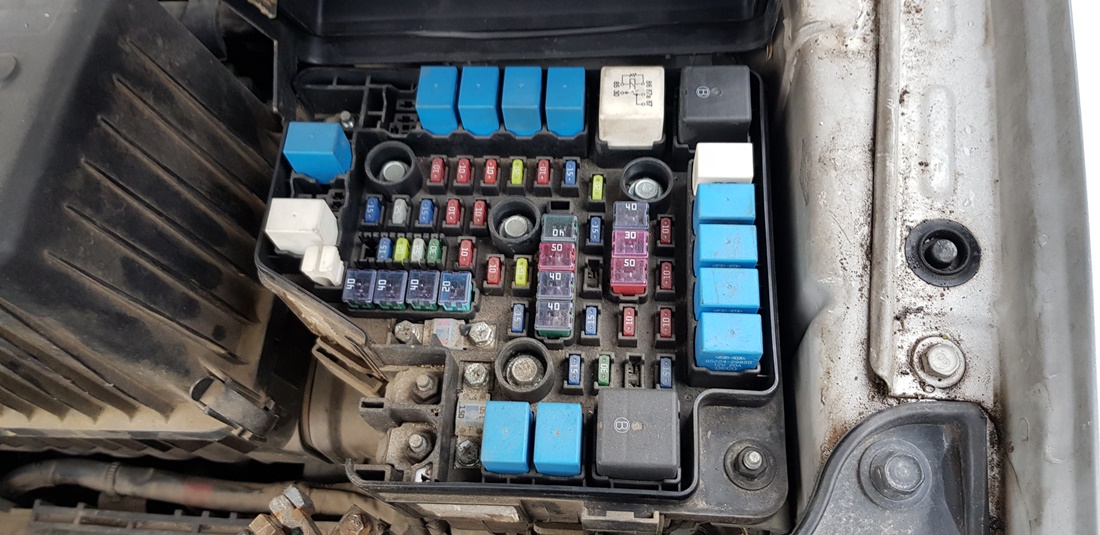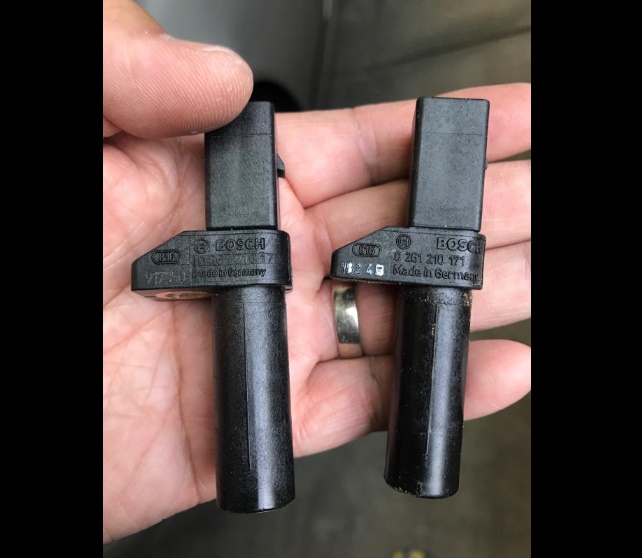The P0327 code is an OBD-II trouble code that stands for Knock Sensor 1 Circuit Low Bank 1 or Single Sensor and is triggered when the knock sensor becomes faulty.
The knock sensor circuit is an electronic device that monitors vibrations in the engine and is used to detect engine knock or detonation.
In this article, I will be talking about the P0327 trouble code, its symptoms, causes, and how to fix it.
- What Does The P0327 Code Mean?
- Which Models Are Affected By The P0327 Code
- What Are The Possible Causes of the P0327 Code?
- What Are The Common Symptoms of The P0327 Code?
- Is It Safe To Drive With a P0327 Code?
- How To Diagnose The P0327 Code
- Most Common Mistakes When Diagnosing The P0327 Code
- How Much Does It Cost To Repair P0327 Code
- What Repairs Can Fix The P0327 Code?
- How To Fix The P0327 Code
- In Conclusion
What Does The P0327 Code Mean?

P0327 is a diagnostic trouble code that means the knock sensor circuit in a vehicle has low voltage. This code is specific to the engine’s bank 1 knock sensor on “V”-shaped engines.
But to understand what the P0327 trouble code means, you must first understand how the knock sensor works.
A “knock” sensor can be found in most modern vehicles. This type of sensor looks at the harmonics of an engine to try to find and fix any problems.
When working properly, an engine’s knock sensor warns a driver of abnormal engine vibrations by turning on the check engine light. The majority of knock sensor “events” are caused by marginalized combustion.
The P0327 trouble code causes an engine’s management software to believe that the sensor in question is unable to provide accurate feedback. Because of this, a car can’t tell the difference between normal and abnormal engine vibrations. This makes it more likely to break down over time.
(See also: P0107 OBD-II Manifold Absolute Pressure/Barometric Pressure Circuit Low Trouble Code)
Which Models Are Affected By The P0327 Code
| Make | Affected By P0327 Code |
|---|---|
| Toyota | Yes |
| Nissan | Yes |
| Chevrolet | Yes |
| BMW | Yes |
| Audi | Yes |
| Buick | Yes |
| Mercedes | Yes |
| GMC | Yes |
| Suzuki | Yes |
| Tata | Yes |
| Lexus | Yes |
| Mazda | Yes |
| Mitsubishi | Yes |
| Kia | Yes |
| Jeep | Yes |
| Fiat | Yes |
| Honda | Yes |
| Hyundai | Yes |
| Opel | Yes |
| Ford | Yes |
| Fiat | Yes |
| Peugeot | Yes |
What Are The Possible Causes of the P0327 Code?
The P0327 trouble code is caused when the knock sensor becomes faulty and is unable to report any excess vibrations or knock to the vehicle’s computer.
The P0327 diagnostic trouble code can be caused by a variety of underlying issues, some of which are far more common than others. Understanding these potential causes can help you repair your vehicle more quickly.
Several of the most common causes of the P0327 trouble code are listed below.
- Faulty knock sensor
- Wiring harness issue
- Damaged/corroded electrical connectors
- Failed PCM (powertrain control module)
- Faulty 02 sensor
- Low engine compression
- A faulty ignition coil or spark plugs
- Leaky fuel injectors
- Leaking intake manifold gasket
- Faulty vacuum hoses or connections
- Oil contamination of the knock sensor
(See also: P0351 OBD-II Ignition Coil A Primary/Secondary Circuit Trouble Code)
What Are The Common Symptoms of The P0327 Code?
The P0327 diagnostic trouble code is frequently accompanied by a number of additional symptoms, the majority of which vary in severity. Recognizing these symptoms is often helpful in determining the underlying cause of such problems.
Several of the most common symptoms associated with the P0327 trouble code are listed below.
- Illuminated check engine light
- Engine misfires or runs rough
- Backfiring or popping sound from the engine
- Poor fuel economy
- Loss of power or acceleration
- Difficulty starting the engine
- Sudden loss of engine power
Also, the diagnostic trouble code P0327 may show up without any other symptoms, though this happens very rarely.
Is It Safe To Drive With a P0327 Code?
No, it is not safe to drive with the P0327 trouble code. This code indicates an issue with the knock sensor. If the problem is not addressed, it can cause further damage to the engine and reduce its performance.
Nonetheless, whenever possible, one should take the time to diagnose and repair the root cause of their vehicle’s P0327 trouble code. When you fix these things, the knock sensor works again, and the annoying check engine light goes away.
How To Diagnose The P0327 Code
If you want to diagnose the P0327 trouble code, you should follow the steps below.
- Scan the ECM for codes and examine the freeze frame data.
- Check the engine wiring harness with a DVOM (digital volt-ohm meter) for any open or shorted wires.
- Unplug the knock sensor and test it with an ohmmeter if no problems are discovered with the electrical system.
- Replace the knock sensor if its resistance is low (less than 0.5 Ohms).
- If you have access to an oscilloscope, you can look for any signs of low voltage in the engine computer’s input to the knock sensor circuit.
- If everything appears to be in order, replace the ECM.
Most Common Mistakes When Diagnosing The P0327 Code
Some of the most common mistakes that may be made when diagnosing a P0327 code are:
- When using Freeze Frame Data, the cause of the problem is not correctly identified.
- Failure to inspect the engine wiring harness for shorts and open circuits.
- Failure to properly test the knock sensor using an ohmmeter or oscilloscope.
- Tools that are not properly calibrated
Always use a scan tool to check for codes and never rely solely on driver inputs. Also, always double-check your work, and don’t forget the fundamentals.
How Much Does It Cost To Repair P0327 Code
It costs between $100 and $155 to repair the P0327 code. A knock sensor costs between $34 and $50 while labor is between $50 and $100.
| Make | P0327 Code | Repair Cost |
|---|---|---|
| Toyota | Yes | $100 – $155 |
| Nissan | Yes | $100 – $155 |
| Chevrolet | Yes | $100 – $155 |
| BMW | Yes | $100 – $155 |
| Audi | Yes | $100 – $155 |
| Buick | Yes | $100 – $155 |
| Mercedes | Yes | $100 – $155 |
| GMC | Yes | $100 – $155 |
| Suzuki | Yes | $100 – $155 |
| Tata | Yes | $100 – $155 |
| Lexus | Yes | $100 – $155 |
| Mazda | Yes | $100 – $155 |
| Mitsubishi | Yes | $100 – $155 |
| Kia | Yes | $100 – $155 |
| Jeep | Yes | $100 – $155 |
| Fiat | Yes | $100 – $155 |
| Honda | Yes | $100 – $155 |
| Hyundai | Yes | $100 – $155 |
| Opel | Yes | $100 – $155 |
| Ford | Yes | $100 – $155 |
| Fiat | Yes | $100 – $155 |
| Peugeot | Yes | $100 – $155 |
What Repairs Can Fix The P0327 Code?
Repairs that can fix the P0327 code include the following:
- Examine the sensor’s wiring for frayed or broken wires.
- Examine the connections for corroded or loose connections.
- Verify the knock sensor’s resistance.
- Check the wires and connections that connect to and from the knock sensor and PCM/ECM.
- Check that the knock sensor is receiving the correct voltage.
- Changing the knock sensor.
- Replacing the PCM/ECM.
How To Fix The P0327 Code
To fix the P0327 code, you need to:
- Check the wiring and connectors at the knock sensor.
- Change the knock sensor for proper operation.
- Inspect the intake manifold for leaks or damage.
- Check the PCM for any stored codes.
- Replace the knock sensor if necessary.
- Check the crankshaft position sensor.
- Check the fuel pressure and fuel injectors.
- Clean or replace the spark plugs.
- Inspect the ignition coils and spark plug wires.
- Ensure the engine is properly timed.
- Replace the spark plug wires if necessary.
In Conclusion
The P0327 code is a diagnostic trouble code that refers to a cylinder-one knock sensor inside the engine and informs the Engine Control Module (ECM) of an improperly functioning knock sensor.
The ECM uses this information to make precise decisions about timing and fuel delivery to reduce engine knocking within certain limits. If the knock sensor on Bank 1 produces a low output voltage, the P0327 trouble code is set.
The most common causes of this code are a faulty knock sensor, faulty electrical connectors, engine control module faults, and open or shorted circuits within the engine’s wiring harness or the knock sensor itself.




